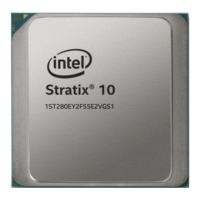Options Value Description
For dual P30/P33 CFI flash, select the density that is equivalent
to the sum of the density of two flash memories. For example,
if you use two 512-Mb CFI flashes, you must select CFI 1 Gbit.
Flash interface
data width
CFI Parallel Flash:
• 8
• 16
• 32
Specifies the flash data width in bits. The flash data width
depends on the flash memory device you use. For multiple
flash memory device support, the data width must be the same
for all connected flash memory devices.
Select the flash data width that is equivalent to the sum of the
data width of two flash memories. For example, if you are
targeting dual P30 or P33 solution, you must select 32 bits
because each CFI flash data width is 16 bits.
User control
flash_nreset
pin
• On
• Off
Creates a flash_nreset pin in the PFL II IP core to connect
to the reset pin of the flash memory device. A low signal resets
the flash memory device. In burst mode, this pin is available by
default.
When using a Cypress GL flash memory, connect this pin to the
RESET# pin of the flash memory.
Table 20. PFL II Flash Programming Parameters
Options Value Description
Flash
programming IP
optimization
• Area
• Speed
Specifies the flash programming IP optimization. If you
optimize the PFL II IP core for speed, the flash programming
time is shorter, but the IP core uses more LEs. If you optimize
the PFL II IP core for area, the IP core uses less LEs, but the
flash programming time is longer.
FIFO size — Specifies the FIFO size if you select Speed for flash
programming IP optimization. The PFL II IP core uses
additional LEs to implement FIFO as temporary storage for
programming data during flash programming. With a larger
FIFO size, programming time is shorter.
Add Block-CRC
verification
acceleration
support
• On
• Off
Adds a block to accelerate verification.
Table 21. PFL II FPGA Configuration Parameters
Options Value Description
External clock
frequency
— Specifies the user-supplied clock frequency for the IP core to
configure the FPGA. The clock frequency must not exceed two
times the maximum clock (AVST_CLK) frequency acceptable by
the FPGA for configuration. The PFL II IP core can divide the
frequency of the input clock maximum by two.
Flash access
time
— Specifies the access time of the flash. You can get the
maximum access time that a flash memory device requires
from the flash datasheet. Intel recommends specifying a flash
access time that is the same as or longer than the required
time.
For CFI parallel flash, the unit is in ns and for NAND flash, the
unit is in us. NAND flash uses page instead of byte and requires
more access time. This option is disabled for quad SPI flash.
Option bits byte
address
— Specifies the start address in which the option bits are stored in
the flash memory. The start address must reside on an 8-KB
boundary.
See related for more information about option bits.
continued...
3. Intel Stratix 10 Configuration Schemes
UG-S10CONFIG | 2018.11.02
Send Feedback
Intel Stratix 10 Configuration User Guide
47

